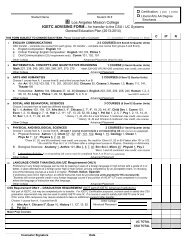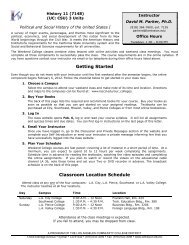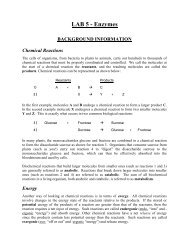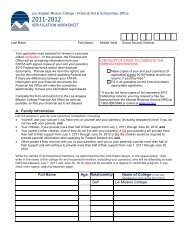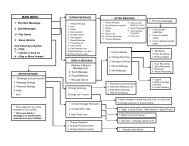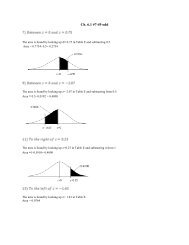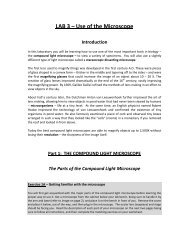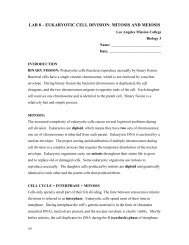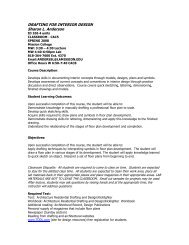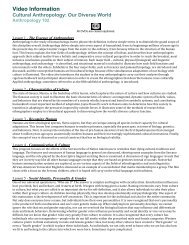Lab #6 - Cellular Respiration
Lab #6 - Cellular Respiration
Lab #6 - Cellular Respiration
You also want an ePaper? Increase the reach of your titles
YUMPU automatically turns print PDFs into web optimized ePapers that Google loves.
when fermenting will produce CO 2 and ethanol instead. This process, known as alcohol<br />
fermentation, is the basis for beer and wine production. Regardless of the fermentation<br />
products, the purpose of fermentation is always the same – to regenerate NAD + so that<br />
glycolysis can continue to produce 2 ATP per glucose without interruption.<br />
In the following exercise you will investigate alcohol fermentation in yeast under different<br />
conditions and measure the production of one fermentation product – CO 2 .<br />
Exercise 1 – Observing and Measuring Alcohol Fermentation in Yeast<br />
1. You will use the following table to mix the proper amounts<br />
of water, yeast solution and corn syrup (a source of sugar)<br />
in small beakers. Be sure to add the yeast last. This will<br />
allow the reactions to begin at approximately the same<br />
time. Before you begin, review the experiment, write<br />
your hypothesis on your worksheet, and identify the<br />
independent and dependent variables as well as the<br />
control.<br />
Tube #1 Tube #2 Tube #3<br />
Water 8 ml 6 ml 4 ml<br />
Yeast 0 ml 2 ml 4 ml<br />
Corn syrup 4 ml 4 ml 4 ml<br />
TOTAL 12 ml 12 ml 12 ml<br />
1. Once complete, transfer each mixture to a labeled<br />
saccharometer (do not overfill), then gently tilt until no air<br />
is trapped inside the top of the tube. At this point you will<br />
begin the timing of your experiment (record on your<br />
worksheet).<br />
saccharometer<br />
2. At 5 minute intervals, use the graduations on the side of the saccharometer to read the volume<br />
of gas collected in ml for a total of 30 minutes.<br />
3. Record the data on your worksheet, graph the data, and answer any associated questions.<br />
Part 2: CELLULAR RESPIRATION<br />
While 2 ATP per glucose molecule is clearly better than nothing, it is not nearly enough to meet<br />
the energy needs of complex multicellular organisms such as plants and animals. To get the<br />
maximum ATP yield from molecules of glucose requires cellular respiration, which and produce<br />
up to 36 ATP per glucose molecule. In aerobic organisms, cellular respiration requires O 2 (which<br />
is why we breathe!), hence the term aerobic respiration.



